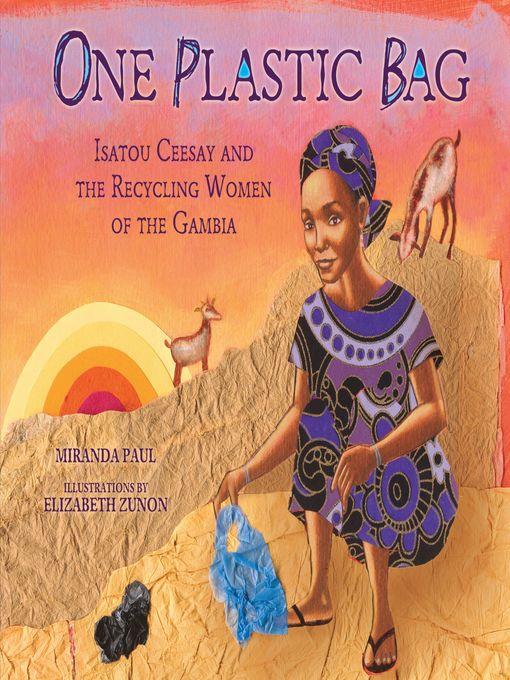
One Plastic Bag
Isatou Ceesay and the Recycling Women of the Gambia
فرمت کتاب
ebook
تاریخ انتشار
2015
Lexile Score
570
Reading Level
0-2
ATOS
2.9
Interest Level
K-3(LG)
نویسنده
Elizabeth Zunonشابک
9781467762991
کتاب های مرتبط
- اطلاعات
- نقد و بررسی
- دیدگاه کاربران
نقد و بررسی

otto bros - One Plastic Bag by: Miranda Paul Have you ever thrown trash on the ground? If you have, you will like this book. This book is about plastic bags that are getting thrown on the ground. My favorite part of the book is when they make something out of it. You will have to read to find out what they are going to make. My name is Gavin Otto and this is awesome. I recommend this book because it teaches you not to litter!

December 22, 2014
One woman’s efforts to rid her Gambian village of trash sparks a recycling movement in this uplifting tale inspired by true events. As a girl, Isatou admired the colors and myriad uses of the plastic bags that began to proliferate in her community. But years later, the same plastic bags, festering in trash heaps or floating through the air, have become a menace to humans and animals. Compelled to make her home beautiful, Isatou gathers the bags, cleans them, and crochets them into purses. She teaches other women to do the same, and an ecologically-minded enterprise is born. Notes of hope, determination, and empowerment suffuse Paul’s story, which the author explains was informed by her volunteer work as a teacher in the Gambia. Incorporating real plastic bags into her mixed-media collages, Zunon, who grew up in West Africa, juxtaposes the brown, dusty landscape against splashes of color and vibrant printed dresses and head coverings worn by the village women. A glossary and list of suggested reading are included. Ages 5–9. Author’s agent: Karen Grencik, Red Fox Literary. Illustrator’s agent: Lori Nowicki, Painted Words.

Starred review from December 1, 2014
Gr 1-4-The simple format of this picture book belies the strength of its content, a story lovingly supported by charming collage illustrations. As a girl, Ceesay realized that the goats on which her village relied were dying because they were eating plastic bags. She also saw that people were tossing the used bags on the ground just as they had always thrown away their baskets when no longer useful-except the plastic bags, unlike the baskets, weren't biodegradable. So Ceesay figured out how to use crochet, a skill with which the villagers were already familiar, to make purses out of the plastic bags. Simple but lyrical text conveys this beautiful, thought-provoking tale of ecological awareness and recycling ("The basket tips. One fruit tumbles. Then two. Then ten."). An inspiring account.-Dorcas Hand, Annunciation Orthodox School, Houston, TX
Copyright 2014 School Library Journal, LLC Used with permission.

November 15, 2014
Distressed by the problem of plastic-bag disposal, a Gambian woman organizes her neighbors to turn trash into treasure.When Isatou Ceesay first discovered plastic bags in the Gambia in West Africa, in the 1980s, they seemed wonderfully useful and sturdy. But in her village, they soon became a nuisance, piling up in ugly dump areas where mosquitoes bred. Goats ate them and died. Her solution was to collect and clean used bags, cut them into strips and crochet the strips into useful plastic purses. These were sold at local markets and eventually internationally. Paul, who first went to the Gambia as a volunteer and has returned in other roles, tells this story in a straightforward fashion, deftly including words from the Wolof language and including details about Ceesay's village life. A map, author's note, glossary, timeline and excellent suggestions for further reading set this example of a woman who made a difference in a larger context. Fittingly, the collage illustrations make use of colorful papers and plastic bags. These reveal the labor involved and show the women's joy in the results of their work. Though Isatou Ceesay's country may be unfamiliar to young readers, they've probably done some handicraft recycling of their own. The easy connection makes this a welcome addition to the small shelf of examples of ingenuity in developing nations. (Informational picture book. 5-8)
COPYRIGHT(2014) Kirkus Reviews, ALL RIGHTS RESERVED.

February 15, 2015
Grades K-3 As Isatou Ceesay, a young woman in Njau, Gambia, drops and breaks the basket of fruit she is carrying, she discovers an abandoned bag made of a strange fabricplastic. At first these brightly colored bags seem convenient throughout the village, but as they break, they are discarded. As 1 becomes 2, then 10, then 100, their beauty turns into a growing pile of filth that attracts dirty water, mosquitos, and a stench. When the problem worsens as goats begin to eat the bags and die, Isatou and her friends devise a clever plan that's initially met with ridicule. They wash the bags, cut and roll them into plastic thread, and crochet them into purses, all in secret. But when 1, then 2, then 10 women buy them, proud entrepreneur Isatou soon has enough money to buy a new goat and relishes the returned beauty of her village. Colorful textured and patterned collage artwork illustrates this inspiring true story, which concludes with more information about Isatou's grassroots initiative.(Reprinted with permission of Booklist, copyright 2015, American Library Association.)

























دیدگاه کاربران